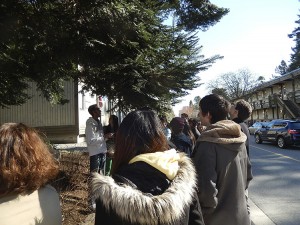 Abies grandis, commonly known as the Grand Fir, is a coniferous tree of the Pinaceae family. The word Abies comes from the Latin word abeo which translates into “to rise.” As the tree can reach up to 80 meteres tall, “to rise” seems quite fitting. The common name “Grand Fir” also refers to the amazing height of these trees. Abies grandis is native to North America, specifically British Columbia, Northwestern USA (Idaho, Montana, Oregon, Washington), and Southwestern USA (California).
Abies grandis, commonly known as the Grand Fir, is a coniferous tree of the Pinaceae family. The word Abies comes from the Latin word abeo which translates into “to rise.” As the tree can reach up to 80 meteres tall, “to rise” seems quite fitting. The common name “Grand Fir” also refers to the amazing height of these trees. Abies grandis is native to North America, specifically British Columbia, Northwestern USA (Idaho, Montana, Oregon, Washington), and Southwestern USA (California).
Abies grandis is monoecious, meaning a single plant contains both male and female reproductive structures. The seed cones of the Grand Fir are typically 6-12cm long, are short and spherical in  shape, and have approximately 100-150 scales. Seed cones are also yellowish green at maturity and grow upright on branches. The cones also have short bracts. During autumn, the scales of the cone are shed along with the seeds. Pollen cones are cylindrical in shape and yellowish at maturity. Interestingly, they hang from branches so they are situated below female cones. This spatial separation between female and male cones prevents self fertilization, a phenomenon which reduces genetic variability.
shape, and have approximately 100-150 scales. Seed cones are also yellowish green at maturity and grow upright on branches. The cones also have short bracts. During autumn, the scales of the cone are shed along with the seeds. Pollen cones are cylindrical in shape and yellowish at maturity. Interestingly, they hang from branches so they are situated below female cones. This spatial separation between female and male cones prevents self fertilization, a phenomenon which reduces genetic variability.
 When young, bark is smooth and greyish brown. As the tree matures, the bark tends to become increasingly scaly. The leaves of Abies grandis are flattened needles with round tips and can range from 3-6cm long. The adaxial side of the leaf is dark green, while the abaxial side has two white bands running from tip to base. These white bands are actually stomata that run down the leaf in a long line. The leaves are arranged generally within the same flat plane. Branches, on the other hand, do not grow in the same plane but tend to droop and spread around the trunk.
When young, bark is smooth and greyish brown. As the tree matures, the bark tends to become increasingly scaly. The leaves of Abies grandis are flattened needles with round tips and can range from 3-6cm long. The adaxial side of the leaf is dark green, while the abaxial side has two white bands running from tip to base. These white bands are actually stomata that run down the leaf in a long line. The leaves are arranged generally within the same flat plane. Branches, on the other hand, do not grow in the same plane but tend to droop and spread around the trunk.
The Okanagan first nations used the bark of Abies grandis to build canoes. They also used the pitch of the tree to coat canoe paddles for a nice finish. To achieve better grip, first nations also coated the back of hunting bows with pitch. The Kwakwaka’wakw, a first nations group of British Columbia, would use the branches of Abies grandis to weave headdresses for shamans. Branches were also used for scrubbing prior to rites and rituals. The Hesquiat First Nations, a group based on Vancouver Island, British Columbia, used the branches of Abies grandis for incense, and decorative clothing. They also used the pitch as an ingredient for perfume.
References:
“Abies grandis“. National Center For Biotechnology Information. N.p., n.d. Web. <http://www.ncbi.nlm.nih.gov/Taxonomy/Browser/wwwtax.cgi>
Earle, Christopher J., ed. “Abies grandis“. The Gymnosperm Database. N.p. 2012. Web. <http://www.conifers.org/pi/Abies_grandis.php>
Parish, Roberta et al. “Tree Book: Learning To Recognize Trees of British Columbia”. Canadian Forest Service, 1994. Web. <http://www.for.gov.bc.ca/hfd/library/documents/treebook/grandfir.htm>
“Abies grandis.” Germplasm Resources Information Network – (GRIN). USDA, ARS, National Genetic Resources Program, National Germplasm Resources Laboratory, Beltsville, Maryland. 2007. Web. <http://www.ars-grin.gov/cgi-bin/npgs/html/tax_search.pl>
Wonders, Dr. Karen. “First Nations: Land Rights and Environmentalism in British Columbia.” N.p., 2008. Web. <http://www.firstnations.de/fisheries/kwakwakawakw.htm>
